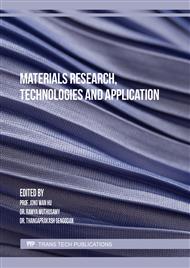[1]
B. Sha, S. Dimov, C. Griffiths, M.S. Packianather.., Investigation of micro-injection moulding: Factors affecting the replication quality, J. Mater. Process. Technol. 12 (2007) 284–296.
DOI: 10.1016/j.jmatprotec.2006.10.019
Google Scholar
[2]
P.S. Minh, T.T. Do, T.H.T. Uyen, The feasibility of external gas-assisted mold-temperature control for thin-wall injection molding, Adv. Mech. Eng., 10 (2018) 1 - 13.
DOI: 10.20944/preprints201806.0361.v1
Google Scholar
[3]
K.F. Zhang, Z. Lu, Analysis of morphology and performance of PP microstructures manufactured by micro injection molding, Microsyst Technol, 14 (2008) 209 – 214.
DOI: 10.1007/s00542-007-0412-3
Google Scholar
[4]
T.T. Do, T.M.T. Uyen, P.S. Minh, The Feasibility of an Internal Gas-Assisted Heating Method for Improving the Melt Filling Ability of Polyamide 6 Thermoplastic Composites in a Thin Wall Injection Molding Process, Polymers 13 (2021) 1 – 17.
DOI: 10.3390/polym13071004
Google Scholar
[5]
S.-Y. Yang, S.-C. Nian, S.-T. Huang and Y.-J. Weng, A study on the micro-injection molding of multi-cavity ultra-thin parts, Polym. Adv. Technol., (2011).
DOI: 10.1002/pat.1593
Google Scholar
[6]
P.S. Minh, M.-T. Le, Improving the Melt Flow Length of Acrylonitrile Butadiene Styrene in Thin-Wall Injection Molding by External Induction Heating with the Assistance of a Rotation Device, Polymers 13 (2021) 1 – 18.
DOI: 10.3390/polym13142288
Google Scholar
[7]
S. C. Chen, R. D. Chien, S. H, Lin, M. C. Lin, J. A. Chang, Feasibility evaluation of gas-assisted heating for mold surface temperature control during injection molding process, Int. Commun. Heat Mass Transf. 36 (2009) 806-812.
DOI: 10.1016/j.icheatmasstransfer.2009.06.007
Google Scholar
[8]
S. C. Chen, W. R. Jong, J. A. Chang, H. S. Peng, Simulation and verification on rapid mold surface heating/cooling using electromagnetic induction technology, 4th International Conference on Heat Transfer, Fluid Mechanics and Thermodynamics Cairo, Egypt, (2005).
DOI: 10.1109/icmech.2005.1529359
Google Scholar
[9]
N. T. Giang, P. S. Minh, T. A. Son, T. M. T. Uyen, T. H. Nguyen, H. S. Dang, Study on external gas-assisted mold temperature control with the assistance of a flow focusing device in the injection molding process, Materials 14 (2018) 965.
DOI: 10.3390/ma14040965
Google Scholar
[10]
P. S. Minh, T. T. Do, T. M. T. Uyen, The feasibility of external gas-assisted mold-temperature control for thin-wall injection molding, Adv. Mech. Eng. 10 (2018) 1687814018806102.
DOI: 10.20944/preprints201806.0361.v1
Google Scholar
[11]
T. T. Do, T. M. T. Uyen, P. S. Minh, The feasibility of an internal gas-assisted heating method for improving the melt filling ability of polyamide 6 thermoplastic composites in a thin wall injection molding process, Polymers 13 (2021) 1004.
DOI: 10.3390/polym13071004
Google Scholar
[12]
T. M. T. Uyen, N. T. Giang, T. T. Do, T. A. Son, P. S. Minh, External gas-assisted mold temperature control improves weld line quality in the injection molding process, Materials 13 (2020) 2855.
DOI: 10.3390/ma13122855
Google Scholar
[13]
T. M. T. Uyen, T. T. Do, P. S. Minh, Internal Gas-Assisted Mold Temperature Control for Improving the Filling Ability of Polyamide 6+ 30% Glass Fiber in the Micro-Injection Molding Process, Polymers 14 (2022) 2218.
DOI: 10.3390/polym14112218
Google Scholar
[14]
P. S. Minh, D. T. V. Anh, Effect of Vibrations on the Weld-Line Strength of Injection Molded Products, 330 (2022) 125 – 130.
DOI: 10.4028/p-3ko8h1
Google Scholar



